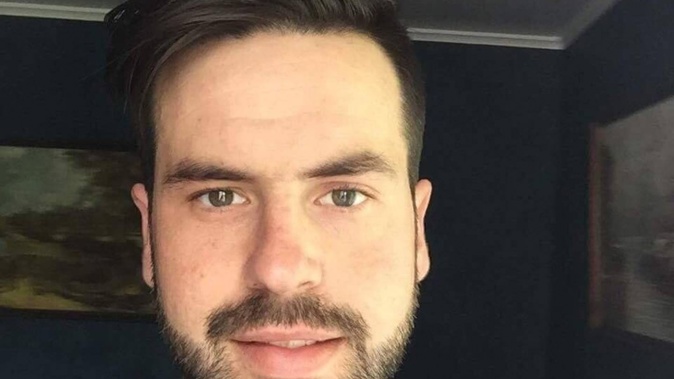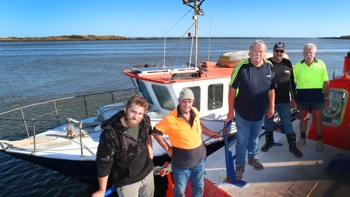

The deteriorating mental state of a soon-to-be father who was shot and killed by police after he smashed a machete into a patrol car windscreen following a pursuit, was exacerbated by methamphetamine.
According to Coroner Debra Bell, Jerrim Marshall Toms had bipolar disorder and had meth, cannabis, alcohol, caffeine and nicotine in his system when he was shot at 12 times by police on State Highway 1 near Puhoi in the early hours of March 31, 2018.
Four of those bullets struck the 29-year-old, with the two that pierced his left chest - including one that first went through his thumb - causing bleeding into the chest cavity that was almost immediately fatal.
Despite that Toms turned and ran and the two unnamed officers fired seven more shots before the young man collapsed and died.
Twelve days later Toms’ first child, a daughter, was born in Germany.
/cloudfront-ap-southeast-2.images.arcpublishing.com/nzme/WUJOO5CZEKTPQF6OSPPRFOZE4Q.jpg) After the shooting of Jerrim Toms, State Highway 1 north of Auckland remained closed for much of the day. Photo / Tess Nichol
After the shooting of Jerrim Toms, State Highway 1 north of Auckland remained closed for much of the day. Photo / Tess Nichol
Coroner Bell found Toms’ mental health care in the months preceding his death was appropriate and he had a loving and supportive family who did all they could to help him.
On the night of his death Toms, an apprentice mechanic described by his boss as a hard worker, was looking for methamphetamine and left his home in Auckland after 2am.
He drove to the BP Connect in Greenlane, filled his car with petrol, was aggressive to the attendant and drove off without paying heading north onto State Highway 1.
Shortly after, Toms’ mother and sister contacted the mental health crisis team who referred them to police.
At 2.51am his mother Joan phoned 111 and requested a welfare check saying she’d fled after Toms threatened to burn down her house, he had a large bayonet-life knife strapped to his hip and he may have taken “P” earlier that day.
A police officer who went to Toms’ house found it empty and recorded that no further action be taken.
It meant the event was no longer visible to a police dispatcher, no alert was entered into the police system, and no radio broadcast was made regarding Toms or his white Subaru Legacy.
Another officer came across Toms sitting alone in his car on the side of SH1 at 3am and described him as “wild-eyed”.
Toms became demanding and approached the officer in his car with the machete.
/cloudfront-ap-southeast-2.images.arcpublishing.com/nzme/IUJRBJGHQI6RFHSZM6BK5KNIVM.jpg) The machete used by Jerrim Toms on the night he fatally confronted police on SH1. Photo / IPCA
The machete used by Jerrim Toms on the night he fatally confronted police on SH1. Photo / IPCA
Officer C reversed away and called for back up and the police Eagle helicopter, a dog handler and other officers were sent to assist.
Toms’ registration number showed he was wanted on driving charges but there was no history of poor mental health or the earlier call to police that night.
By 4am Toms had smashed out his own taillights and was leading police on a pursuit at speeds of up to 140kmh without his headlights on, despite an order to officers not to pursue.
Two police officers were tailing Toms when his car was spiked a third time.
He got out swinging the machete as he walked toward officers AB and BC, who asked Toms to stop and drop the weapon, but he didn’t.
When Toms was just over a metre away, Officer AB fired at Toms together with Officer BC.
After being shot Toms ran about 45 metres before collapsing. There were five gunshot wounds from the four bullets that hit Toms.
Coroner Bell said Toms’ mental health care leading up to his death was appropriate.
Prior to his first presentation to mental health services in January 2016 when he suffered a manic episode with psychotic features, Toms frequently smoked cannabis and took Ritalin pills, as well as occasionally smoking methamphetamine.
/cloudfront-ap-southeast-2.images.arcpublishing.com/nzme/2U4CNMS6SBBSIND2IG7FD454ZA.jpg) Superintendent Tusha Penny speaks to media hours after the police pursuit and shooting death of Jerrim Toms. Photo / Jason Oxenham
Superintendent Tusha Penny speaks to media hours after the police pursuit and shooting death of Jerrim Toms. Photo / Jason Oxenham
He recovered from that episode and Coroner Bell said Toms’ condition was deemed to be in remission after a brief stay at Te Whetu Tawera [TWT] in February 2018. On March 2, his mother verified Toms was taking his medication.
There had been no indication initially that he posed a serious danger to himself or others and although Toms was sometimes hard to contact, community mental health workers were always able to reach his mother who reported appeared well.
A March 15 review also found Toms was well but after his death none of the prescribed medications he needed to manage his mental health were detected in his system.
Coroner Bell said closer to his death there was clear evidence suggesting a decline in Toms’ mental health with witnesses portraying the “troubling changes” he experienced during that time.
“I note that Mr Toms’ sister expressed her concerns to [social worker] Mr [Andrew] Colwell, revealing that she had noticed a significant shift in his behaviour, and was particularly worried that he might be experiencing paranoid delusions.
“She raised concern about him using methamphetamine and mentioned that he might not have slept the previous night.”
Coroner Bell noted use of methamphetamine could trigger a more dramatic and rapid change in a person’s behaviour, potentially exacerbating the underlying mental health condition, which she considered to be the case for Toms.
She considered it unlikely that failing to take medication alone could have caused relapse over such a short period and to such an extent as seen in Toms’ behaviour on the night he died.
The coroner said prolonged use of meth resulted in disorienting impacts on cognition, reasoning and psychomotor ability may arise.
“Importantly, high dose or chronic use of methamphetamine can even lead to the occurrence of delusions and psychotic episodes.
“Of particular significance is Mr Toms’ admission to TWT in February 2018, during which he was experiencing persecutory delusions in the context of using methamphetamine, cannabis, alcohol and Ritalin.
“Considering the facts, I consider that medication non-adherence, along with substance abuse, appears to have played pivotal roles in Mr Toms’ declining mental state, ultimately leading to the unfortunate circumstances surrounding his death.”
She made no recommendations but endorsed TWT’s, including that families be offered face-to-face contact when a patient fails to engage.
She extended her deepest sympathies to Toms’ family.
“It is not often that I encounter a family that has continually supported a loved one throughout their mental health struggles.
“Mr Toms’ family is one such family. In particular, Mr Toms’ mother who has been at his side throughout, there is nothing else she could have done to prevent his tragic death.”
Natalie Akoorie is a senior reporter based in Waikato and covering crime and justice nationally. Natalie first joined the Herald in 2011 and has been a journalist in New Zealand and overseas for 28 years, more recently covering health, social issues, local government, and the regions.

Take your Radio, Podcasts and Music with you









